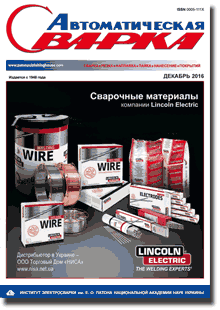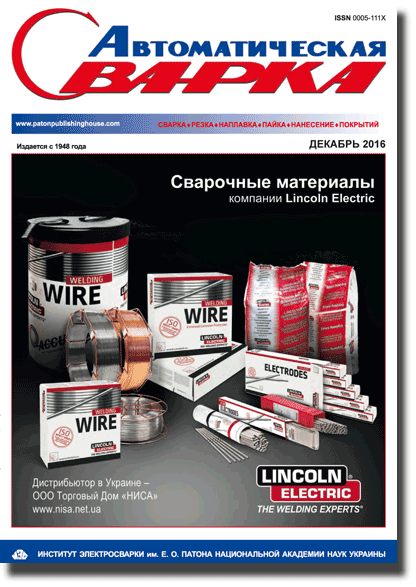| 2016 №12 (05) |
DOI of Article 10.15407/as2016.12.06 |
2016 №12 (07) |

Avtomaticheskaya Svarka (Automatic Welding), #12, 2016, pp. 36-40
Mathematical model of welding circuit in robotic consumable electrode arc welding
G.A. Tsybulkin
E.O. Paton Electric Welding Institute, NASU 11 Kazimir Malevich Str., 03680, Kiev, Ukraine. E-mail: office@paton.kiev.ua
Abstract
In the article the mathematical model of dynamic processes, running in the welding circuit during robotic gas-shielded arc welding using consumable electrode, is investigated The welding circuit is considered as a self-stabilizing system with a feedback by the electrode melting rate. Unlike the known mathematical models, in the investigated model the dependence of the electrode melting rate on actual values of welding current and arc voltage is taken into account. The basic aim of the article is the study of reaction of welding circuit on external disturbances arising in the process of arc welding. In the frames of the developed model the criteria for asymptotic stability were established, which in addition to the already known criteria impose certain limits on the parameters of arc welding mode itself, which is important from the practical point of view. Using the computer modeling a good correlation of this model with the real processes, running in welding circuit, was illustrated. 14 Ref., 4 Figures.
Keywords: robotic arc welding, consumable electrode, welding circuit, mathematical model, stability of welding processes
Received: 06.09.16
Published: 24.01.17
References
- Pan, J. (2003) Arc welding control. Woodhead Publishing Ltd.
- Tsybulkin, G.A. (2014) Adaptive control in arc welding. Kiev: Stal.
- Sugitani, Y. (2000) Making best use of the arc sensor. of JWS, 69(2), 46–50.
- Ushio, M. (1991) Sensors in arc welding. of JWRI, 20(2), 157–163.
- Sudnik, V.A., Ivanov, A.V. (1998) Mathematical model of heat source in metal-arc shielding-gas welding. Pt 1. Normal process. Proizvodstvo, 9, 3–9.
- Korinets, I.F. (1995) Mathematical model of electrode wire melting in arc welding. Svarka, 10, 39–43.
- Paton, B.E., Lebedev, V.K. (1966) Electric equipment for arc and slag welding. Moscow: Mashinostroenie.
- Leskov, G.I. (1970) Electric welding arc. Moscow: Mashinostroenie.
- Barbashin, E.A. (1967) Introduction in stability theory. Moscow: Nauka.
- Finkelnburg, V., Mekker, G. (1961) Electric arcs and thermal plasma. Moscow: Inostr. Literatura.
- Nikitin, V.P. (1934) Electric machines and transformers for arc welding. Moscow; Leningrad: Energoizdat.
- Tsybulkin, G.A. (2008) On the influence of small parameters on MIG/MAG welding stability. The Paton Welding J., 8, 22–25.
- Dyurgerov, N.G., Sagirov, Kh.N. (2009) Stability of system of arc self-adjustment in mechanized and automatic welding. Proizvodstvo, 2, 13–14.
- (1986) Automation of welding processes. Ed. by V.K. Lebedev et al. Kyiv: Vyshcha Shkola.
The cost of subscription/purchase order journals or individual articles
| Journal/Currency | Annual Set | 1 issue printed |
1 issue |
one article |
| TPWJ/USD | 384 $ | 32 $ | 26 $ | 13 $ |
| TPWJ/EUR | 348 € | 29 € | 24 € | 12 € |
| TPWJ/UAH | 7200 UAH | 600 UAH | 600 UAH | 280 UAH |
| AS/UAH | 1800 UAH | 300 UAH | 300 UAH | 150 UAH |
| AS/USD | 192 $ | 32 $ | 26 $ | 13 $ |
| AS/EUR | 180 € | 30 € | 25 € | 12 € |
| SEM/UAH | 1200 UAH | 300 UAH | 300 UAH | 150 UAH |
| SEM/USD | 128 $ | 32 $ | 26 $ | 13 $ |
| SEM/EUR | 120 € | 30 € | 25 € | 12 € |
| TDNK/UAH | 1200 UAH | 300 UAH | 300 UAH | 150 UAH |
| TDNK/USD | 128 $ | 32 $ | 26 $ | 13 $ |
| TDNK/EUR | 120 € | 30 € | 25 € | 15 € |
AS = «Automatic Welding» - 6 issues per year;
TPWJ = «PATON WELDING JOURNAL» - 12 issues per year;
SEM = «Electrometallurgy Today» - 4 issues per year;
TDNK = «Technical Diagnostics and Non-Destructive Testing» - 4 issues per year.





